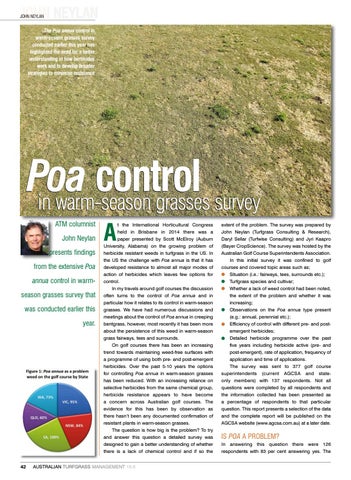JOHN NEYLAN JOHN NEYLAN
The Poa annua control in warm-season grasses survey conducted earlier this year has highlighted the need for a better understanding of how herbicides work and to develop broader strategies to minimise resistance
Poa control in warm-season grasses survey ATM columnist John Neylan presents findings from the extensive Poa annua control in warmseason grasses survey that was conducted earlier this year.
42
A
t the International Horticultural Congress held in Brisbane in 2014 there was a paper presented by Scott McElroy (Auburn University, Alabama) on the growing problem of herbicide resistant weeds in turfgrass in the US. In the US the challenge with Poa annua is that it has developed resistance to almost all major modes of action of herbicides which leaves few options for control. In my travels around golf courses the discussion often turns to the control of Poa annua and in particular how it relates to its control in warm-season grasses. We have had numerous discussions and meetings about the control of Poa annua in creeping bentgrass, however, most recently it has been more about the persistence of this weed in warm-season grass fairways, tees and surrounds. On golf courses there has been an increasing trend towards maintaining weed-free surfaces with a programme of using both pre- and post-emergent herbicides. Over the past 5-10 years the options for controlling Poa annua in warm-season grasses has been reduced. With an increasing reliance on selective herbicides from the same chemical group, herbicide resistance appears to have become a concern across Australian golf courses. The evidence for this has been by observation as there hasn’t been any documented confirmation of resistant plants in warm-season grasses. The question is how big is the problem? To try and answer this question a detailed survey was designed to gain a better understanding of whether there is a lack of chemical control and if so the
AUSTRALIAN TURFGRASS MANAGEMENT 18.6
extent of the problem. The survey was prepared by John Neylan (Turfgrass Consulting & Research), Daryl Sellar (Turfwise Consulting) and Jyri Kaapro (Bayer CropScience). The survey was hosted by the Australian Golf Course Superintendents Association. In this initial survey it was confined to golf courses and covered topic areas such as; l Situation (i.e.: fairways, tees, surrounds etc.); l Turfgrass species and cultivar; l Whether a lack of weed control had been noted, the extent of the problem and whether it was increasing; l Observations on the Poa annua type present (e.g.: annual, perennial etc.); l Efficiency of control with different pre- and postemergent herbicides; l Detailed herbicide programme over the past five years including herbicide active (pre- and post-emergent), rate of application, frequency of application and time of applications. The survey was sent to 377 golf course superintendents (current AGCSA and stateonly members) with 137 respondents. Not all questions were completed by all respondents and the information collected has been presented as a percentage of respondents to that particular question. This report presents a selection of the data and the complete report will be published on the AGCSA website (www.agcsa.com.au) at a later date.
IS POA A PROBLEM? In answering this question there were 126 respondents with 83 per cent answering yes. The
